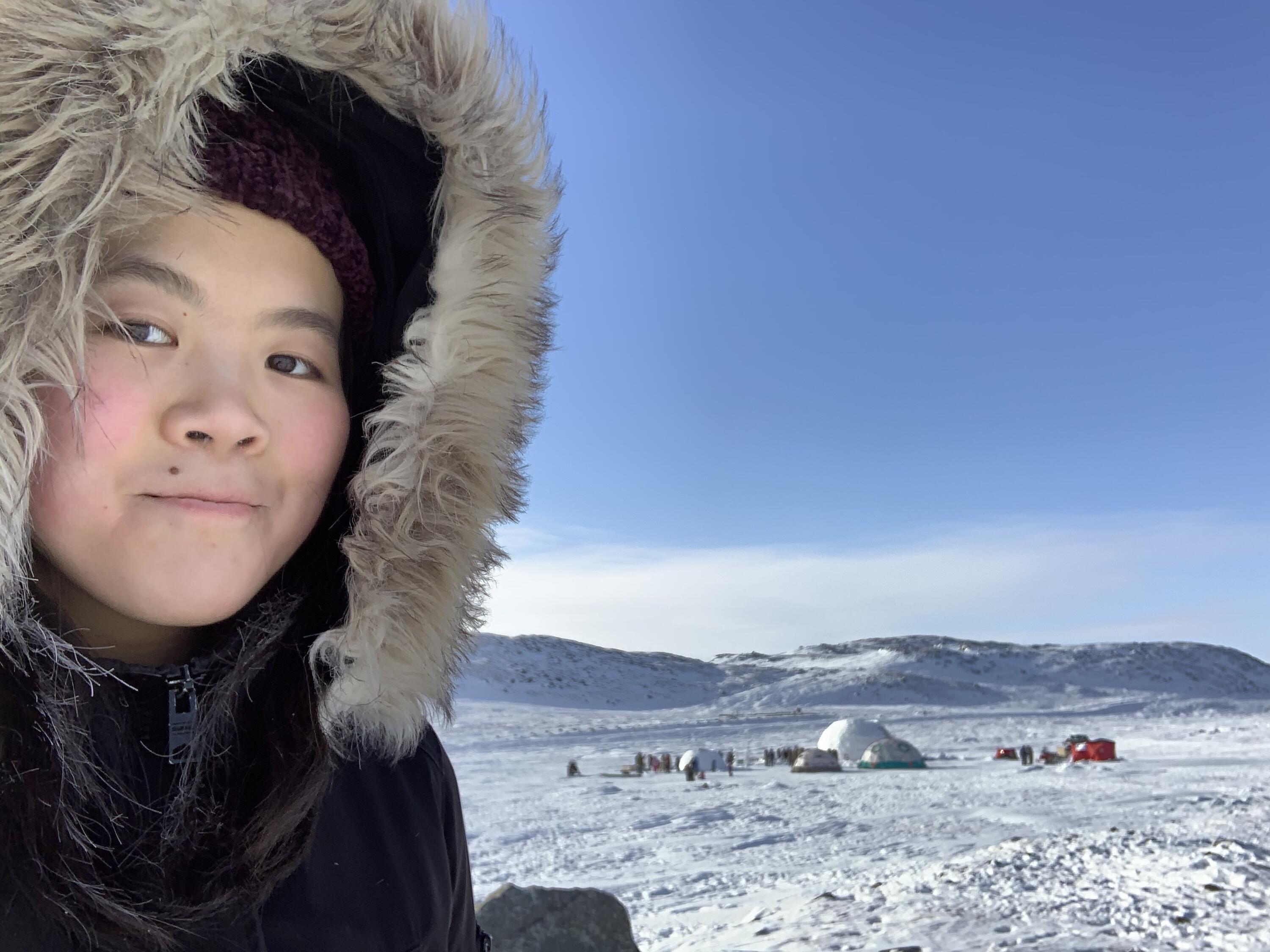In the Preface of her book, Our Ice is Vanishing / Sikuvut Nunguliqtuq, Shelley Wright encapsulates the issue,1
The Arctic is ruled by ice. For Inuit, it is the platform on which life is lived. But the ice is melting and becoming dangerous. Inuit are silaup aalaruqpalianigata tusaqtittijiit – witnesses and messengers of climate change.
Rosalina’s reflections on climate change
I shall begin with my own family reminiscences.
“In my home community of Ikpiarjuk (Arctic Bay), 20 years ago, my father used to go hunting every mid-July by snowmobile to the floe edge outside of Arctic Bay. Today, that isn’t possible since the ice melts much earlier towards the end of June and early July. My cousins said that this year too, the seals were sunbathing earlier than they did.”
 FIGURE 1
FIGURE 1
Rosalina Naqitarvik ice-fishing near Ikpiarjuk (Arctic Bay), NU. Credit: Rosalina Naqitarvik
Now I am living in Iqaluit. Even in recent years, I have seen dramatic changes:
“This past winter, I think there has only been one blizzard that occurred. Even just five years ago, I remember the blizzards used to frequent way more often and every building would shut down. This year’s spring is super early as well! In March, the snow melted quick, and the roads became clear. It is becoming muddy, and the weather has been calm way earlier than usual. Spring usually arrives in May here in Iqaluit, but it seems to be over a month in advance this year.”
In Article nine, “Living on the edge: Some chemistry of the Inuit diet,” we quoted the words of Martin Martin, Elder of Nunainguk (Nain) Nunatsiavut on climate change and its effects there. For this closing article, I have interviewed Elders from across Nunavut to obtain their thoughts and recollections.
Inuit quotes about climate change in their communities
Qaumajuq Oyukuluk, Elder of Ikpiarjuk (Arctic Bay) contrasts the former stability of the climate to now, and the thinness of the ice:
“Long ago, when I was a young boy, the weather did not seem so different – from one year to the next – compared to now. It is very noticeable how now the weather is getting warmer. The ice is getting thinner throughout the whole winter.”
Annie Demcheson, Elder of Iqaluit notes that the Spring is no longer sunny and cold. The weather now is cloudy and food resources are less:
“In the past during the spring season it would get warmer, and we would get snow-blind in the springtime. It was brighter during that season. Right now, it is cloudier out. Every year in the fall we used to go blueberry picking, they’d grow abundantly. Now, the blueberry population seems to be different. In the low tide, there seemed to be more seaweed and ugly fish in the past. I don’t see many barnacles on the rocks anymore either. We used to have plentiful of snow buntings and more birds called sijjaria. We used to have more bumblebees in the summers too, back then.”
Tony Manik, Elder of Qausuittuq (Resolute Bay), one of Canada’s northernmost communities, expresses worry about climate instability:
“I remember the weather used to be more stable, now it’s so unpredictable. It is all over the place, it becomes warm in January, then the next week it is really cold.”
Ulujuk Sateana of Kangiqliniq (Rankin Inlet) is concerned by the lack of snow compared even to 20 years ago:
“Twenty years ago, we had tons of snow on our rooftops and the temperature was mostly around -50 °C. Even during our spring fishing, we would have to shovel three to four feet of snow in order to drill through the ice. Today, the temperature is warmer and there’s hardly any snow according to our local hunters. Their snowmobiles are having some ski-rod issues due to no snow out in the hunting land area.”
A younger voice
The young people of the North are very concerned about the climate change to come. Katie Yu, a 15-year-old grade 10 student in Iqaluit (Fig. 2), has become a vocal activist:3
“Our northern community is warming about three times faster than the global average. This is already thinning the sea ice that many of us (and Arctic species) depend on for hunting and land travel as well as thawing the permafrost that underlies our roads, water systems and buildings. I want Arctic ecosystems to be preserved because with that comes appreciation of the land and preservation of Inuit culture, along with food security, good health and wellbeing.”
Our future
In this series, we have touched on several aspects of our way of life and culture as they relate to chemistry. Our culture and our way of life are inseparable.2 As the Inuit activist, Sheila Watt-Cloutier has stated:4
Inuit people have a right – a human right –
to be cold.
Our culture will always survive – and Canada will be richer for our contributions. However, we fervently hope that our way of life can be saved.
 FIGURE 2
FIGURE 2
Katie Yu in front of a qaggiq (large communal igloo) near Iqaluit, NU. Credit: © Katie Yu. https://wwf.ca/stories/what-youth-can-doto- fight-climate-change
References
- Wright, S. Preface, Our Ice is Vanishing/Sikuvut Nunguliqtuq: A History of Inuit, Newcomers, and Climate Change; McGill-Queen’s University Press, 2014.
- Arctic Culture and Climate, Lincoln, A.; Cooper, J.; Loovers, J.P.L., Eds.; Thames and Hudson, 2020.
- Yu, K. What Youth Can Do to Fight Climate Change. World Wildlife Fund Stories, November 1, 2021. https://wwf.ca/stories/what- youth-can-do-to-fight-climate-change.
- Watt-Cloutier, S. The Right to Be Cold: One Woman’s Story of Protecting Her Culture, the Arctic and the Whole Planet; University of Minnesota Press, 2018.







